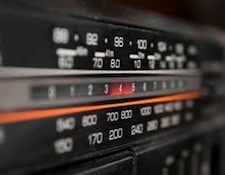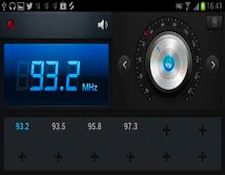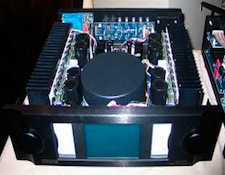It’s the time of year for saving money!
Back in the 1950s a new phenomenon – or at least one new to me – came along that created a massive stir in the Hi-Fi community: FM radio. Until that time, what we were all used to was AM – Amplitude Modulated “regular” radio: You know, the kind of broadcasting that we heard on our table radios and in our (if we were sixteen and had our license and owned or had access to one) car, or in our parents’ car, if we weren’t or didn’t.
 Commercially broadcast AM radio had been around since the early 1920s and, if I remember correctly, building a “crystal set” AM radio – one that used no electronics at all, but that picked up radio signals with just a long wire antenna and a galena diode, for headphone listening, was still one of our very first projects High School “Electric Shop”.
Commercially broadcast AM radio had been around since the early 1920s and, if I remember correctly, building a “crystal set” AM radio – one that used no electronics at all, but that picked up radio signals with just a long wire antenna and a galena diode, for headphone listening, was still one of our very first projects High School “Electric Shop”.
AM radio is broadcast by modulating the amplitude (the volume or loudness) of a fixed carrier frequency in the Kilohertz range that, for commercial broadcasters, has been assigned by the Federal Communications Commission (FCC). The “modulation” involved simply means changing the volume level of the fixed carrier frequency to correspond with the level and frequency of the voice or music signal to be broadcast, and amounts to, in effect, just a really fast volume control operating to affect the level of the transmitted carrier wave. In theory (and even occasional practice) it’s possible for AM radio to carry music signals up to as high as 15kHz, but, because AM radio can carry for very long distances and because AM radio stations were assigned (by the FCC and other world regulatory agencies) very closely spaced on the allowable carrier frequency spectrum (which can allow for possible overlaps and interference), AM broadcast transmission has generally been limited by the operators or regulators to a total musical signal spectrum of around just 5kHz.
Other stations weren’t the only possible sources of interference with AM radio, either; power lines, lightning, sunspots, and any number of other things could also affect and mask or add noise to AM broadcast signals.
What all that meant, of course, was that – at least as it was usually broadcast – AM was better suited to speech, and its sound quality for music left much to be desired.
 FM, on the other hand, is the opposite of AM in almost every respect. For the first and most obvious reason, it’s Frequency Modulated. That means that, instead of changing the amplitude of a fixed carrier frequency as AM does, FM changes the frequency of a variable carrier wave above or below its assigned center point. Because the frequencies assigned for FM broadcasting are in the Megahertz (rather than kilohertz) range and because its stations neither “carry” for as long a physical distance as AM, nor are assigned as closely together in carrier wave frequency, FM radio is able to have considerably broader real musical frequency-response capability than AM. This, coupled with the fact that environmental noise doesn’t have the same effect on carrier wave frequency as it does on carrier wave amplitude, makes FM considerably quieter, less prone to interference, “static” and other noise than AM, and, all-in-all a far better choice for music broadcasting. (It has also, for many of the same reasons, been mandated for TV sound by the FCC since the early days of commercial TV broadcasting.)
FM, on the other hand, is the opposite of AM in almost every respect. For the first and most obvious reason, it’s Frequency Modulated. That means that, instead of changing the amplitude of a fixed carrier frequency as AM does, FM changes the frequency of a variable carrier wave above or below its assigned center point. Because the frequencies assigned for FM broadcasting are in the Megahertz (rather than kilohertz) range and because its stations neither “carry” for as long a physical distance as AM, nor are assigned as closely together in carrier wave frequency, FM radio is able to have considerably broader real musical frequency-response capability than AM. This, coupled with the fact that environmental noise doesn’t have the same effect on carrier wave frequency as it does on carrier wave amplitude, makes FM considerably quieter, less prone to interference, “static” and other noise than AM, and, all-in-all a far better choice for music broadcasting. (It has also, for many of the same reasons, been mandated for TV sound by the FCC since the early days of commercial TV broadcasting.)
FM was loved by Hi-Fi Crazies even in the earlier parts of the ’50s, when it was Mono. It was the “downloading” of its day, and if you had an FM tuner and a tape (or even wire) recorder, you could record whole libraries of practically any kind, mood, style or nationality of music you might want.
FM radio continued to grow in popularity with the audiophiles of the time, and, in the late’50s when stereo records came along and multiplexed stereo FM radio allowed them to be played on, or if you had the right gear (I had a Viking stereo tape recorder), recorded off the air, it became a necessary part of every audio enthusiast’s system. By the ’60’s, when multiplexed FM stereo became readily available to most homes in the United States, and a little later, most car radios, the popularity of FM stereo transcended the audiophile market entirely, and FM radio seemed to be firmly established not only with Hi-Fi Crazies, but with the mainstream, as well.
 Stereo FM radio became a standard feature of every car radio, every portable radio — from “shirt pocket” to “Boom Box” – and of every “Mid-Fi” receiver. It also became the object of some very serious and very expensive High End research that was rewarded with such landmark products as the [$799 in 1964] Marantz 10B tuner (“Yeah, it’s wonderful, but no, nothing that expensive could ever sell”), the later [$1,699 in 1972] McIntosh MR78 (“Yeah, it’s wonderful, but no, nothing that expensive could ever sell”), and the still later [$1,800 in 1973] Sequerra Model 1 (“Yeah, it’s wonderful, but no, nothing that expensive could ever sell”), all of which, even today, are still regarded as wonderful and DO sell, in excellent used condition, for LOTS of thousands of dollars.
Stereo FM radio became a standard feature of every car radio, every portable radio — from “shirt pocket” to “Boom Box” – and of every “Mid-Fi” receiver. It also became the object of some very serious and very expensive High End research that was rewarded with such landmark products as the [$799 in 1964] Marantz 10B tuner (“Yeah, it’s wonderful, but no, nothing that expensive could ever sell”), the later [$1,699 in 1972] McIntosh MR78 (“Yeah, it’s wonderful, but no, nothing that expensive could ever sell”), and the still later [$1,800 in 1973] Sequerra Model 1 (“Yeah, it’s wonderful, but no, nothing that expensive could ever sell”), all of which, even today, are still regarded as wonderful and DO sell, in excellent used condition, for LOTS of thousands of dollars.
]]> Following later in the footsteps of the “Classic Three” were seriously excellent, but more affordably-priced tuners from Dick Sequerra’s co-worker at Marantz, Jim Bongiorno (the Sumo “Charlie” – I own one); from Kinergetics’ Tony DiChiro (the KBT-1 , which I wanted to buy, but Tony never had time to build one for me);and from Canada’s Magnum Dynalab (a whole range of great tuners, including the FT-101. I’ve got one of those, too!).
Every one of those great tuners – the classics and all of the others that I mentioned — was quiet, imaged, soundstaged, had superb dynamics, life-like transient attack and decay, wonderful tonality, and usually sounded as good as any of the CDs of their day. I only say “usually”, incidentally, because, possibly because of the extra effective “dither” added by the broadcast/reception process, they sometimes actually sounded better than the same CD played simultaneously for an “A-B” comparison.
Really good FM was really good Hi-Fi, and in “those thrilling days of yesteryear” anybody putting together a high-intention system automatically included quality FM radio as a part of it. Unfortunately, that doesn’t still appear to be the case today.
Following later in the footsteps of the “Classic Three” were seriously excellent, but more affordably-priced tuners from Dick Sequerra’s co-worker at Marantz, Jim Bongiorno (the Sumo “Charlie” – I own one); from Kinergetics’ Tony DiChiro (the KBT-1 , which I wanted to buy, but Tony never had time to build one for me);and from Canada’s Magnum Dynalab (a whole range of great tuners, including the FT-101. I’ve got one of those, too!).
Every one of those great tuners – the classics and all of the others that I mentioned — was quiet, imaged, soundstaged, had superb dynamics, life-like transient attack and decay, wonderful tonality, and usually sounded as good as any of the CDs of their day. I only say “usually”, incidentally, because, possibly because of the extra effective “dither” added by the broadcast/reception process, they sometimes actually sounded better than the same CD played simultaneously for an “A-B” comparison.
Really good FM was really good Hi-Fi, and in “those thrilling days of yesteryear” anybody putting together a high-intention system automatically included quality FM radio as a part of it. Unfortunately, that doesn’t still appear to be the case today.
 Magnum Dynalab is still around, and I’ve been told that their $6,000 flagship tuner is glorious. The Accuphase T-1000 (which I’ve never heard) is also said to be one of the all-time greats. There are apparently others doing great stuff, too, but although there are still people out there making great FM radio products, some of the great companies are gone, and FM doesn’t seem to be a necessary part of anybody’s system anymore. People don’t seem to talk about it, or listen to it (except in their cars) and I truly don’t remember the last time I saw a serious review of a tuner or a discussion of FM radio in any of the major audiophile blogs or print publications.
Maybe, as with “Twitter”, I’m just old and “out of it”, and maybe there’s still a whole thriving world of
FM radio manufacturers to produce it and FM radio fans to listen to it that I know nothing about, but if there isn’t…
Whatever happened to FM radio?
Magnum Dynalab is still around, and I’ve been told that their $6,000 flagship tuner is glorious. The Accuphase T-1000 (which I’ve never heard) is also said to be one of the all-time greats. There are apparently others doing great stuff, too, but although there are still people out there making great FM radio products, some of the great companies are gone, and FM doesn’t seem to be a necessary part of anybody’s system anymore. People don’t seem to talk about it, or listen to it (except in their cars) and I truly don’t remember the last time I saw a serious review of a tuner or a discussion of FM radio in any of the major audiophile blogs or print publications.
Maybe, as with “Twitter”, I’m just old and “out of it”, and maybe there’s still a whole thriving world of
FM radio manufacturers to produce it and FM radio fans to listen to it that I know nothing about, but if there isn’t…
Whatever happened to FM radio?





